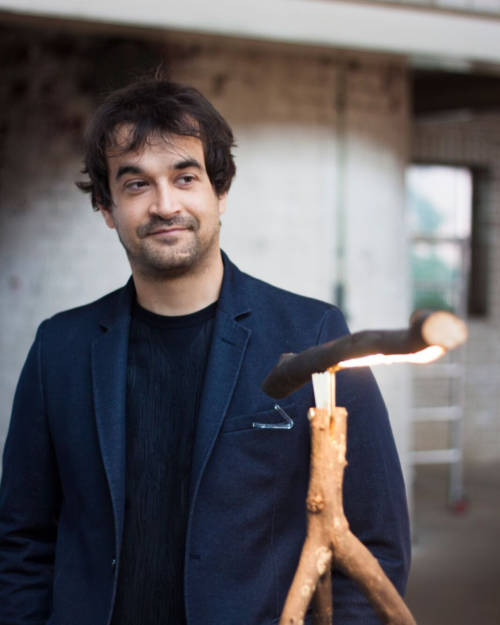
Marco Iannicelli and The Poetry Of Impermanence
Sacha Walckhoff, a guest speaker at GC’s forthcoming Botany Salon and a maker of one of our shop’s most celebrated items, the Reverso vases, once interviewed fellow nature-inspired designer Marco Iannicelli about his amazing tree lamp concept, “Tree Friends”. Walckhoff wrote about the experience below, in an article that originally appeared in Prussian Blue Magazine Issue #10, which was published in French in July 2016.
Last Autumn in London, I saw Marco Iannicelli’s work for the first time: in a posh South Kensington gallery, a long tree bough rested upside down on its narrower branches. The form was slender and elegant. Then I noticed an electric wire set in the wood and a cut at the top of this strange object. “Press the top if it!” suggested the gallery owner – so I did. The top shifted under the pressure and light surged out– it was a lamp! It’s unusual that a utilitarian object inspires so much emotion. This branch, which diffuses light almost by magic, recalls man’s discovery of fire when he created a spark by rubbing a wood stick against a stone.

I wanted to know more about the creator of this contemporary design miracle and that’s how I met Marco Iannicelli; the first time was in Paris last January, when his Snappy Tree Friend (the name of this particular branch light) was shown in the Wild Exhibit at the Maison et Objet International Design Fair; then again in Milan, during the 2016 Milano Design Week, where he presented his prototype for a chair made of recycled leather. The chair was for the Buxkin Company and came on oak or steel made by Archiproducts.
“When Marco proposes a piece, it’s up to us to react, make sense of it and even to theorize…. Aware of the reactions to his work, he’s modest and doesn’t reveal himself– the work does it for him.”
We breakfast together in a Milan sidewalk café, enjoying the gentle sunlight and sipping our strong coffee. Iannicelli’s Italian parents moved to Aachen, Germany in the 1960s, and he enjoys being an Italian who speaks his mother tongue with a German accent. After studying classical languages and psychology, he enrolled at the Art Academy of Maastricht in The Netherlands and created a design studio in 2010 after receiving his diploma. This is an extremely endearing 32-year-old, as we sense his determination, strength and fragility, his self-doubt counterbalanced by solid convictions. Marco is a complex, sensitive, creative human being who bubbles over with ideas! On Vimeo, we can watch Origination, a lovely film of him walking through the forest, looking for branches that will become his Tree Friends. He invites us to his studio to see how he transforms raw materials into amazing objects.
On his site, Marco has created two categories: “Products” and “Non Products”. The “Non Products” concept interests me since it’s not the first time I’ve met a young designer who develops ephemeral projects and transformations, a far cry from today’s commercial obsessions. For example, Marco’s Sysiphos is a kinetic, modular object (as he defines it)– a wood box that comes in different sizes and has a brass mechanical attachment system. The boxes can be endlessly separated from each other and then reassembled… for the beauty of the gesture. Could this be a metaphor that criticizes our consumer society and penchant for accumulating possessions, even the absurd or the nonsensical? I ask him about Sysiphos and he answers: “These are pretty boxes”… When Marco proposes a piece, it’s up to us to react, make sense of it and even to theorize. He likes to construct, find solutions, share, and collaborate with other designers. Aware of the reactions to his work, he’s modest and doesn’t reveal himself– the work does it for him.
The black wax shape resembles an office lamp but, when plugged in, the lampshade melts since the light bulb is inside the wax. Light appears – then part of the object disintegrates. What’s his explanation? “Decay is beautiful”.
Another creation, the Waxlamp, speaks to the senses. This black wax shape resembles an office lamp but, when plugged in, the lampshade melts since the light bulb is inside the wax. Light appears – then part of the object disintegrates. What’s his explanation? “Decay is beautiful”. It is this poetry in Marco Iannicelli’s work that is captivating, the idea that nothing is permanent, appearances are multiple and no object or person actually belongs to us. As a designer, some of his pieces go beyond the context of classic design and are more like the contemporary art pieces seen in the top galleries.
When I ask him about his current project, he surprises me (again) by explaining that he is collaborating with designer Marco Lanzoni. Their idea: each begins a design project without revealing the sense or subject to the other. Halfway through, they exchange the projects without explanation and each finishes the other’s work, changes its use or even destroys it. For me, this recalls “exquisite cadavers” the game invented by the surrealists in the 1920s. Jacques Prévert, Max Ernst, Man Ray, even André Breton created drawings or texts where none of the others knew what they were doing and exchanged them for completion. The results were often surprising. This modern approach is a reinvention since Marco had never heard about the “exquisite cadavers”. I’m thrilled to rediscover the procedure, almost a century later, now adopted for the design world. It reinforces my conviction that Marco and his accomplices are artist-designers to watch in the future.
This article originally appeared in French in Prussian Blue Magazine Issue #10, which was published in July 2016.












































